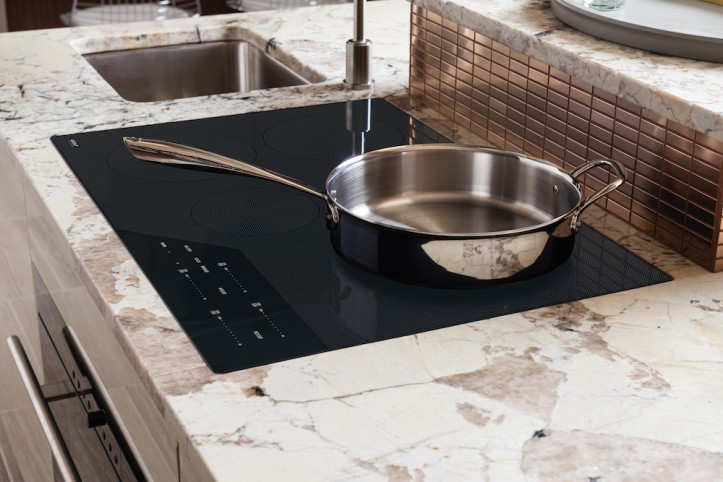Induction Cooktops 101
An affordable appliance with a lot to offer
Ceramic glass induction cooktop from Wolf
How do you like to cook? Do you like to prepare gourmet meals? Do you entertain frequently? Are you in a hurry to get dinner on the table? If your answer is yes to any of these questions, you might want to check out one of the hottest “new” entries into home cooking today: the induction cooktop.
While this type of cooking was first introduced to the U.S. about 70 years ago, it is enjoying a surge in popularity, thanks to a couple of factors. A growing demand for this appliance has lowered prices. You can find some models for under $1,000, or as much as a third of what they once cost. The smooth cooking surface answers the demands of another trend: a sleek, uncluttered kitchen. Finally, the precision and speed of induction cooking draws Americans who are increasingly strapped for time at home and welcome the opportunity to cut even minutes from meal prep.
Sweeten, a free service matching homeowners with vetted general contractors, unpacks the many features of induction to help you better understand what’s available and noteworthy.
What is induction?
Induction is a method of producing heat for cooking. It works by creating an interaction between a metal pot or pan and an electromagnetic field below the tempered glass surface of the cooktop to heat the cookware. Induction is the only method that directly uses the cookware as a part of the cooking system.
How does induction work?
Beneath the surface—ceramic or tempered glass—of an induction cooktop rests an induction coil. When the coil is activated (by turning on its control knob or pad), an electrical current passes through this coil, creating an electromagnetic field of energy. Upon contact with that field, the iron molecules in the pan begin to vibrate. It is the friction between those molecules that heats the cookware.
The cooktop surface itself does not emit heat. Rather, heat is produced only when it is turned on and a pan makes contact with the cooktop surface. Once the pan is removed from the cooktop, the magnetic connection is broken and heat is no longer generated. Before the pan makes contact, the cooktop surface, even when it’s been turned on, will remain cool. After the pan is removed from the cooktop, the surface will be warm, but not hot to the touch.
How does induction differ from other heating sources?
Unlike gas or radiant cooktops, there is no exposed flame or coil. If you turn on an induction cooktop, it generates no heat until the appropriate cookware is placed in contact with it. Also, the heat is contained within the circumference of the pan or cooktop. As a result, less energy is generated and wasted because the heat is created only within the pan, and not in the surrounding environment.
Are there distinct benefits?
Clearly, all cooktops are not alike. While any heat source will cook food, and cook it well, induction does have standout features that include:
Safety – The heat happens in the pan, so there’s no danger of accidentally touching a hot cooktop. This is a particular benefit to homes with children or elderly family members.
Accuracy – Precision control at very low or high heat lets the cooktop maintain a temperature to melt chocolate, simmer a cream sauce, or boil pasta water. Sweeten brings homeowners an exceptional renovation experience by personally matching trusted general contractors to your project, while offering expert guidance and support—at no cost to you. Renovate to live, Sweeten to thrive!
Speed – The electromagnetic field below the glass cooktop surface quickly generates heat directly to the pan, so water boils faster—manufacturers claim a quart of water boils in less than two minutes—than with gas or radiant heat.
Energy efficiency – Heat occurs only within the pan where it makes contact with the cooktop, so there’s no energy wasted.
Easy cleaning – A smooth, continuous surface means no crannies where food can catch, and because most of the cooktop stays cool when you’re cooking, spills don’t burn on.
What else is noteworthy?
The unique cooking function—that electromagnetic field—lends itself to lots of interesting options. For instance, most manufacturers make cooktops with multiple cooking zones that can be bridged to create larger zones for, say, a roasting pan or a Dutch oven. Gaggenau’s induction cooktop makes possible the free positioning of cookware within its combined cooking areas. Thermador offers a memory feature that transfers power settings to another cooking area when the pot is relocated. BlueStar, in addition to a warming burner at 150 degrees, has a Power Boost feature—a 5,500-watt burner that claims to bring one gallon of water in a large pot to a rolling boil in only three and half minutes. Previously, induction wasn’t so good for wok cooking because the coil element couldn’t make contact with enough of the wok’s raised surface. Jenn-Air makes an induction wok module for just that purpose.
What about installation or replacement?
Induction cooktops are made to the same dimensions as comparable gas or radiant cooktops—24, 30, 36, and 48 inches. So you can replace your existing cooktop with an induction version of the same dimensions as long as you have an electrical hookup of the same voltage.
If you wish to install an induction cooktop over a wall oven, it’s best done with both appliances from the same manufacturer. However, you will want to consult with your contractor and review the installation instructions to make sure they are compatible.
Most manufacturers that make induction cooktops will also offer ranges with the induction cooktop option.
Is special cookware required?
Induction cooking requires ferromagnetic cookware or pots and pans with an iron core, which allows the transfer of energy to the pan. Your cast iron pieces and most stainless steel should work fine. Hold a magnet to the bottom of the pan; if it sticks, it will work. Glass and other non-metallic items will not, however, since they lack the iron core and will need to be replaced if you opt-in for this type of cooktop.
How about care and maintenance?
Since the unused areas of an induction cooktop remain cool while you are cooking, most spills and splatters will not cook onto the surface. The exception can be foods with sugar content, such as sauces or sweet potatoes. It’s sensible to wipe up any spills quickly with a sponge.
The smooth, continuous surface makes it easy to maintain and keep it looking new—far easier than a gas model with its contours and grates, or radiant, unless it is topped with tempered glass.
Only use a cleaner made for your cooktop. A regular glass cleaner with ammonia will mar the surface. Also, always lift a pot when you transfer it; never slide cookware, as this can scratch the cooktop.
All of these features add up to lots of choice for the home cook. With so much selection and specialization, where do you begin? When shopping for induction, ask for demonstrations. Many showrooms offer cooking classes so you can try your hand at induction cooking. After all, who doesn’t want a little romance before making a commitment?
—
Steam-powered cooking provides an easy way to create healthy meals.
Refer your renovating friends to Sweeten and you’ll both receive a $250 Visa gift card when they sign a contract with a Sweeten general contractor.
Sweeten handpicks the best general contractors to match each project’s location, budget, and scope, helping until project completion. Follow the blog for renovation ideas and inspiration and when you’re ready to renovate, start your renovation on Sweeten.
Updated on April 13, 2024









